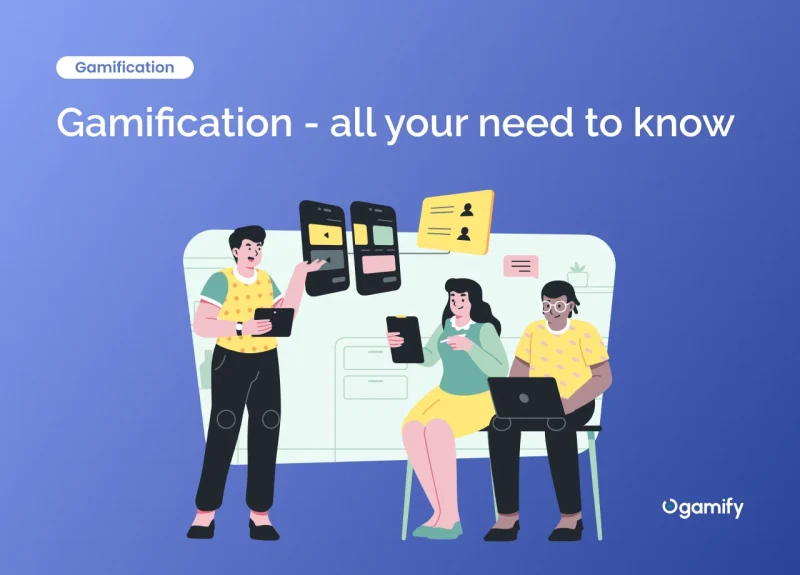Gamification is all around us, from earning rewards for loyalty programs to playing games that track progress and achievements. But what is gamification’s meaning, and why is it so popular?
In this article, we’ll explore gamification’s definition, features, and implementation, including its history, game elements, and real-life applications in various fields such as education, health, marketing, and work management. Whether you’re a business owner, marketer, educator, or just curious about the psychology behind human motivation, this article has everything you need to know about gamification and its impact on our daily lives.
Definition and brief history of gamification

The history of gamification can be traced back to the 1980s when video games first became popular. However, in the early 2000s, businesses began to recognise the potential of gamification’s impact on marketing and employee engagement. In 2010, the term “gamification” was defined by Nick Pelling, a British computer programmer and inventor, who defined gamify meaning as “the use of game thinking and game mechanics in non-game contexts to engage users in solving problems.”
Since then, the impact of gamification has been significant, with businesses in various industries adopting the approach to improve customer loyalty, increase employee productivity, and enhance learning experiences. The gamification definition can be understood as incorporating game mechanics and design elements into non-gaming contexts, such as business, education, and healthcare, to engage and motivate people to achieve specific goals.
Gamification is a way to make activities more fun and engaging, so people are more likely to change their behavior and get involved. When done right, gamification mechanisms can effectively motivate individuals and create engaging experiences that drive results. However, it is essential to note that gamification in real life is not a one-size-fits-all solution. The success of gamification impact depends on the thoughtful design and implementation of game template tailored to the specific context and audience.
Why we use gamification and is it important?
The reason why gamification is important is that it offers numerous benefits that can positively impact businesses, organisations and our everyday life.
For one, it can help increase user engagement and retention, which is crucial in today’s highly competitive digital landscape. By incorporating elements of fun and enjoyment, users are more likely to become invested in a product or service, leading to increased usage and loyalty.
Another reason why use gamification in real life is that it can help drive behaviour change. Users are incentivised to take specific actions aligning with the organisation’s objectives by setting clear goals and rewarding desired efforts. This can be particularly useful in education, healthcare, and fitness, where behaviour change is critical to achieving desired outcomes.
In addition, gamification can also provide valuable insights into user behaviour and preferences. By tracking user interactions with a game-based system, organisations can better understand what motivates their audience and how to tailor their products or services to meet their needs.
Game elements in gamification

The gamification concept uses game elements in non-game contexts to increase user engagement and participation. Several game elements and mechanics are commonly used in gamification systems.
Points, badges, and leaderboards
Points, badges, and leaderboards are some of the most commonly used features of gamification systems. Points are awarded for completing specific tasks or achieving certain milestones, and they measure progress and success. Badges are digital symbols of achievement that users can collect as they progress through the gamification system. Leaderboards, on the other hand, display the scores of top performers, fostering competition and driving participation.
Overall, including points, badges, and leaderboards in gamification systems can help increase user engagement and motivate users to continue using the system.
Rewards
Rewards are a crucial aspect of gamification systems, serving as a powerful motivator for users to engage with the platform. Rewards may include virtual goods, exclusive content, or even real-world prizes. The use of rewards in gamification systems is based on the principles of operant conditioning and behavioural psychology, which suggest that people are more likely to repeat rewarded behaviours.
However, the effectiveness of rewards in gamification systems depends on several factors, such as the design of the rewards system, the type of rewards offered, and the target audience’s preferences. A well-designed rewards system in gamification can create a sense of achievement and progress, leading to increased engagement and motivation. On the other hand, a poorly designed rewards system may lead to user frustration and disengagement. Therefore, it is essential to carefully consider the rewards system’s design, including the type and frequency of rewards offered, to ensure maximum effectiveness.
Challenges and quests
Challenges and quests are common features in gamification systems designed to engage users and motivate them to complete certain tasks or activities. These elements can be used to create compelling game experiences that drive user engagement and loyalty.
Challenges are often short-term activities designed to be completed quickly, such as completing a certain number of tasks within a specific time frame or achieving a certain level of performance in a particular area. Challenges can be designed to be relatively easy or difficult, depending on the desired level of engagement and motivation.
On the other hand, Quests are usually longer-term activities that require a greater investment of time and effort. Quests can involve completing tasks or activities that build upon each other, leading to a larger overall goal or objective. They can be designed to be linear or branching, depending on the desired level of complexity and variety.
Gamification systems may also include challenges or quests, encouraging users to complete certain tasks or achieve specific goals. These challenges can be designed to be progressively more complex, which keeps users engaged and motivated to continue playing.
Feedback systems
Feedback systems are an important component of gamification systems as they provide users with information about their progress and performance, which can be used to motivate and engage them. Effective feedback systems can help users to understand how they are doing, identify areas for improvement, and stay motivated to continue engaging with the gamification system.
Feedback systems should be clear, concise, and relevant to the user’s goals and objectives when designing gamification systems. Feedback should be provided in real-time, whenever possible, to help users stay motivated and engaged. Feedback should also be positive and encouraging, rather than punitive or critical, to help users stay motivated and focused on their goals.
Social engagement
Social engagement is a powerful tool in designing gamification systems, as it can help create a sense of community and foster social connections among users. Social engagement can take many different forms, from simple interactions like commenting or sharing, to more complex activities like collaborative challenges or group competitions.
One way to use social engagement in gamification systems is to incorporate social features that allow users to interact with each other. This can be done through messaging systems, forums, or chat rooms where users can discuss their progress, share tips and advice, and encourage each other to continue engaging with the gamification system.
Another way to use social engagement is to create collaborative challenges or group competitions that require users to work together towards a shared goal. This can help foster teamwork and create a fun and engaging experience that encourages continued participation.
Applications of gamification
In recent years, gamification has been recognized as an effective method for achieving various goals across different fields. From education and health to marketing and productivity, gamification has found its way into many aspects of our daily lives.
Education
Gamification has been shown to enhance the learning experience and improve student engagement. Using gamification tools like quizzes, badges, and leaderboards incentivises students to participate in class, complete assignments, and improve their grades. Gamified educational apps like Duolingo and Quizlet have become increasingly popular, allowing students to learn new skills interactively and engagingly.
In addition, game-based learning has been shown to improve retention rates and help students develop critical thinking skills. Overall, gamification’s impact on education can revolutionise how students learn and interact with educational material. By making learning more enjoyable and personalized, gamification can help students stay motivated and engaged, leading to better learning outcomes.
Health
Gamification has significantly impacted the health and fitness industry, encouraging people to adopt healthy habits and behaviours. Apps like Fitbit and MyFitnessPal have gamified the fitness journey, introducing challenges, rewards, and progress tracking to motivate people to exercise regularly, eat healthy, and track their progress towards their fitness goals.
Gamified apps have made it easier for people to track their mental health, with apps like Headspace using gamification to encourage people to meditate daily and improve their mental well-being.
Gamification can also raise awareness and promote healthy behaviours on a broader scale. Public health campaigns and initiatives can use gamified elements to incentivise healthy behaviours like quitting smoking or getting vaccinated. By making healthy living more fun and engaging, gamification can help people make positive changes to their lifestyles and improve their overall health and well-being.
Marketing
Brands have used gamification impact to engage customers and promote products or services. By introducing gamification mechanisms like contests, sweepstakes, and loyalty programs, brands can incentivize customers to interact with their brands and purchase their products.
Gamification has also been used to drive social media engagement, with brands using interactive games and challenges to encourage users to share branded content and increase their social media presence.
Productivity and work management
Gamification has been used to motivate and improve employees’ performance. Productivity tools like Trello and Asana use gamification techniques like points, badges, and progress tracking to encourage employees to complete tasks, meet deadlines and collaborate with their team members. This creates a sense of healthy employee competition and promotes teamwork, making work more enjoyable and rewarding.
Gamification has also improved employee training by making it more interactive and engaging, allowing employees to retain and apply information to their job.
Web Design
Gamification has also been used in web design to improve user engagement and retention. By incorporating gamification elements into websites, designers can make the user experience more enjoyable and encourage users to spend more time on the site. For example, websites can introduce badges, leaderboards, and progress bars to incentivize users to complete certain tasks, such as filling out a survey or sharing the website on social media. This can increase user loyalty and encourage repeat visits.
Additionally, gamified elements can make website navigation more intuitive and user-friendly, helping users quickly find the information they want. Gamification in web design has become increasingly popular, with many brands using it to create memorable and engaging online experiences for their users.
Charity
Gamification has also been used to encourage charitable giving and fundraising. By introducing gamification tools like challenges, rewards, and progress tracking, charities can incentivise people to donate and raise money for their cause. Gamification has been used in various ways, such as charity walks or runs, where participants can collect badges and compete for prizes.
Gamified donation platforms have also been developed, allowing people to track their donations and earn rewards. In addition, charity games have been developed to raise awareness and funds for various causes, making donating to a good cause easy and fun.
Implementation of gamification
Now you can ask, how to implement gamification mechanics in my business or everyday life? First, you need to start by identifying your business objectives and goals. You must determine what you want to achieve through gamification and how it aligns with your business strategy. Once you have identified your objectives, you can work on designing a gamification plan that meets those objectives. This plan should include the game mechanics, rewards, and incentives that will be used to motivate and engage your target audience.
Next, you need to select the right gamification solution for your business. Many gamification platforms are available, each with features and benefits. You should choose a solution that is easy to use, customizable, and scalable. It should also seamlessly integrate with your existing systems and tools.
Once you have selected the right gamification solution, you can start designing the game mechanics and rewards. The game mechanics should encourage participation, competition, and collaboration. The rewards should be meaningful and relevant to your target audience. They should also be aligned with your business objectives and goals.
Finally, you need to launch and promote your gamification program. You should communicate the benefits of gamification to your target audience and encourage them to participate. You should also track and measure the success of your gamification program regularly and make adjustments as needed.
In conclusion, implementing gamification in your business can be a powerful tool to engage your customers and employees. However, it requires careful planning and execution to ensure its success. Following the steps outlined above, you can design and implement a gamification program that aligns with your business objectives and drives results.
Future directions of gamification

As you can read above, gamification has already significantly impacted various niches, such as education, healthcare, and the workplace. Its effectiveness in motivating and engaging users has been proven repeatedly. As gamification mechanisms continue to advance, the potential for gamification to have a more significant impact in real-life scenarios increases. These tools allow for customised and tailored games that cater to specific audiences and objectives, making for a more effective and engaging user experience.
The convergence of gaming and real life is becoming more apparent with the emergence of virtual and augmented reality technologies. These technologies create immersive experiences that blur the lines between entertainment and education. From virtual museum tours to interactive city tours for tourists, gamification in real life scenarios is becoming more common.
Furthermore, gamification is used in social causes to raise awareness and funds for critical issues such as environmental conservation, poverty alleviation, and human rights. In the future, we can expect even more creative uses of gamification in this space as organisations continue to seek ways to inspire and motivate people to take action.
Overall, the future of gamification is looking bright with the continued advancements in gamification tools and the integration of gaming in real-life scenarios. The potential for gamification to make a positive impact on various niches is more significant than ever before.
Conclusion
Gamification is a concept that involves the integration of game elements into non-game contexts to enhance engagement, motivation, and learning. The gamification definition emphasises using game mechanics, such as points, badges, and leaderboards, to make the experience more enjoyable and rewarding.
The gamification concept can be applied in various fields, including education, health, marketing, and business, to encourage desired behaviours and improve outcomes. The benefits of gamification include increased participation, satisfaction, retention, and better performance and learning outcomes.
How to gamify your business successfully? It is essential to understand the target audience, define clear objectives, and select the appropriate game elements and mechanics. Various gamification tools and platforms, such as game engines, mobile apps, and learning management systems, can simplify gamifying a business. By gamifying your business, you can create a more engaging and motivating environment for your employees and customers and improve your bottom line.


